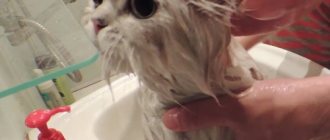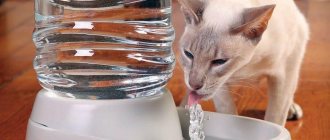Causes of a cat's fear of water
Zoologists, interested in this issue, found that cats are absolutely not afraid of water. Animals are afraid of the consequences of contact with it. A number of main reasons why a cat avoids bathing:
- risk of hypothermia;
- possibility of overheating;
- increased odor upon contact with water;
- fear of attack;
- stress from the imposed bathing procedure.
Sometimes the reasons include the animal's fear of contracting bacteria or infections, as well as the fear of being deaf. However, these are more likely the reasons of the cat owners, rather than the animals themselves.
There are a number of reasons why cats don't like water.
Risk of hypothermia
A cat's fur has a special structure, specific composition and smell. Between the skin and fur of the animal there is a kind of air layer that retains heat. After contact with water, the fur loses its heat-insulating functions and the pet begins to freeze and shiver even in a warm room. In addition, after bathing, the cat’s body temperature decreases by 5–7°, which is why the purr cannot warm up until it dries completely. Of course, at home, a cat is unlikely to run the risk of getting too cold, but at the genetic level, the instinct of self-preservation is triggered, and the pet diligently avoids water treatments.
Possibility of overheating
The air accumulated in a cat's fur can not only protect the animal from the cold, but also save it from overheating on a hot day. The air cushion prevents the sun's rays from heating the animal's delicate skin. The dog escapes the heat by sticking out its tongue and breathing frequently. Cats, alas, don’t know how to do this, so in order not to get their coats wet, they avoid bodies of water even in the heat.
Increased odor upon contact with water
Every cat has a hunter's instinct from birth. She, like a sniper, can wait for hours for a victim in a motionless state. The wet skin begins to intensely emit a specific odor because the body temperature begins to rise sharply. This “amber” can be smelled by potential prey, and the musky runs the risk of being left without lunch. In order not to remain hungry, the cat tries not to come into contact with water.
Wet fur prevents the cat from catching prey and makes it a target for attack.
Fear of attack
A wet cat, spreading its scent, can itself become an object of attack by a stronger and larger predator. Sitting in ambush, the animal does not have the opportunity to lick itself thoroughly to eliminate the incriminating odor. In addition, wet fur becomes heavy and makes it difficult for the cat to quickly retreat in case of danger. It is clear that this does not threaten the pet, but no one has canceled the instinct of self-preservation.
Fear of bacteria and infection
Dry cat fur repels dirt and dust, which contain large amounts of bacteria and pathogens. The wet one, on the contrary, collects them. During licking, pathogenic microflora enter the stomach and can cause significant harm to the pet’s health. Some felinologists believe that a cat intuitively understands the consequences of water procedures for the body.
Fear of going deaf
Hearing, along with other senses, is of great importance for a cat. Water that gets into the ears while swimming can cause inflammation and even lead to complete deafness. It is very difficult for a deaf animal to adapt to the world of sounds, so the cat, anticipating another trouble, is careful of water.
Stress from the imposed bathing procedure
The cat is incredibly clean. She bathes herself several times a day. The pet considers bathing to be a pointless procedure that violates the cat’s comfort. The animal is sincerely perplexed why the owner put it in the hated chlorinated water and lathers it with an incomprehensible substance with a synthetic smell. In addition, the owner’s touch during bath procedures is not always delicate. The cat has no escape route and has to forcefully endure the imposed process.
Animals consider bathing a procedure that has no meaning
It is clear why the purr has difficulty withstanding this “execution” and sometimes falls into a state of stress.
Video: why cats are afraid of water
Despite their dislike of the water element, cats are excellent swimmers. Why do they need this? The reason is simple - the same instinct of self-preservation. In extreme conditions, the pet has to swim, sometimes over quite long distances. The fluffy beauty's ability to swim has been developed since birth. Even one-month-old kittens that fall into the water swim like dogs, quickly moving their paws.
Home Fears
Even the most affectionate cat can instantly become a wild beast if you offend it. She will not hesitate to use her teeth and claws, fighting for the right to remain dry as fiercely as if there were boiling water in the bath. But if you look into why cats don’t like to bathe so much, aggressive behavior will be justified:
- Forcing people to use water procedures is a major mistake. This is not a dog under a leader. Even a hint of force makes the cat instinctively resist. And the more stubbornly the owner stands his ground, the fiercer the fight for freedom.
- The slippery surface of the bath frightens a pet who is accustomed to trusting its tenacious claws. The ground knocked out from under his feet makes him defenseless. There is only one way out - to run at full speed, no matter the cost.
- The sound of water resembles a stormy current or a waterfall. To get there means to die, and the voice of the ancestors sounds the alarm. In such a situation, the cat is not just afraid of water, he is in a real adrenaline panic.
- The stench of household chemicals, air freshener and shampoo causes disgust and a desire to run away immediately. The sense of smell of cats is several times stronger than that of humans - the aromas of fragrances that are pleasant to people torment their sensitive sense of smell.
- When swimming, water floods the ears, nose and eyes. Cats avoid getting their hair wet because they need a keen sense of smell, hearing and vision to survive. And in such conditions you get the feeling that you are about to drown. Well, the instinct of self-preservation will make even a gentle murka attack its owner.
In nature, cats simply do not like water - they do not experience real fear of this element. But at home (after a negative experience), your pet may develop a real phobia, which will be extremely difficult to overcome. To prevent this from happening, it is important to gradually accustom it, without violence and nerves.
Cats that are not afraid of water
Water is not at all dangerous for some felines. Wild cats are not only not afraid of bodies of water, but also spend a lot of time in them. Waterfowl wild cats include:
- tiger;
- jaguar;
- jaguarundi;
- serval;
- Sumatran cat;
- speckled cat (civet cat-fisher).
Cats living in the wild are absolutely not afraid of the consequences of getting their fur wet. They truly enjoy contact with water.
One of the most aquatic wild cats is the speckled cat (wyverrina). It feeds on fish, which it catches by diving 2–3 meters deep. The fishing cat has membranes on its front paws that help it catch fish underwater.
Among domestic animals there are also curious individuals who are absolutely not afraid of water procedures. They happily play with the stream of water, catch their reflection in it, and the bravest ones even take baths with their owners. The following breeds are classified as domestic “swimmers”:
- sphinx;
- Siamese;
- Bengali;
- Cornish Rex;
- Turkish van;
- Kurilian and American bobtail;
- Abyssinian;
- Maine Coon;
- Savannah (a hybrid of a domestic cat and an American serval);
- Norwegian forest;
- sokoke.
The biggest fans of bath treatments are Siamese cats. They go into the water not for hygiene purposes, but to get real pleasure. And Kurilian bobtails not only frolic in the water, but also dive with pleasure.
Our first cat, Sonya, was probably an alien animal. She loved water. We found her in the entrance as a small kitten, we thought that pussy was an ordinary mongrel. It turned out to be a Turkish Angora. Sonya had snow-white and very fluffy fur, so the cat had to be washed quite often. The reasons for the cat’s reverent love for water are difficult to guess. Maybe because, being just a baby, she couldn’t lick herself after going to the litter box, and we constantly washed her under the tap with warm water. Maybe he just liked the sound of water. When one of the family members washed their face, our beauty always watched the process, and sometimes she herself jumped onto the washbasin and touched the water with her paw. And if someone was taking a bath, she couldn’t miss it. She screamed at the door, demanded to be let in, and then jumped onto the side of the bathroom and walked around it. One day I was washing, and Sonya caught the foam with her paw, accidentally slipped and fell into the water with me. And she wasn’t at all scared, but swam like a dog. Such an amazing Catdog. And she was absolutely not afraid to dry her fur with a hairdryer, and even enjoyed it. And this is no exception to the rule. Our relatives have two cats who are absolutely calm about water, and the older cat constantly wets his head under the tap in the heat.
Video: waterfowl cats
Photo gallery: domestic cat breeds that are not afraid of water
Cornish Rex is not averse to jumping into a container of water
Turkish Van cats are always ready for water treatments
Bobtails love not only to splash around, but also to dive into the water
An Abyssinian cat will easily keep a bathing owner company
The Norwegian Forest Cat is not afraid to get its luxurious coat wet.
Savannah is a big fan of water treatments
In order for a Maine Coon to love water, it must be taught to bathe from childhood.
Bengal cats are not afraid of the consequences of contact with water
The Siamese cat is the biggest fan of splashing in the water.
Sphynx cats have a positive attitude towards H2O
The graceful sukoke is not at all afraid of the water element
Owners who want to buy a cat that is ready to take a bath with Spartan calm should take a closer look at waterfowl breeds.
Why dogs love water but cats don't
This question is asked by many people, especially those who keep both cats and dogs. The reason lies in the instincts and physiological characteristics, which are completely different for these domestic animals:
- Even in the wild, the dog obtained food by chasing its prey, rather than tracking it from a hiding place like cats. Therefore, issues of camouflage and, in particular, the smell emanating from the body were not so important.
- Dogs know how to shake themselves off, and in addition, their fur dries out much faster than a cat's.
- The process of thermoregulation in cats passes through the fur and skin, and in dogs - through the oral cavity.
Therefore, you should not compare dogs and cats. The process of accustoming these animals to water is radically different.
Also watch the video why cats are afraid of water:
How to help an animal overcome its fear of water
It is better to accustom a cat to water from early childhood. Kittens are more curious and playful than adults. Habituation should be gradual and unobtrusive. The first thing you need to do is let the kitten understand that water is not dangerous. Let him listen to the murmur of the stream and enter the bathroom without fear. The easiest way to make friends with water is through play. To do this you need:
- take 5–7 cm of water at a temperature of 37–39° into a bowl or small basin;
- place the container in a place where the kitten likes to be;
- Carefully, without splashing, throw objects into the basin that may interest the purr;
- wait until the pet touches them with its paw and starts playing;
- help the kitten wet its paws (if the animal is not afraid, you can put it in the water for a while);
- gradually increase the amount of water in the basin;
- When the kitten gets used to a basin of water, you can introduce it to the bath (all the same actions as with the basin).
The best way to teach a cat to bathe is with toys.
If an animal categorically does not come into contact with water, you should not force it. The process of adaptation to bathing in an adult cat is much more complicated, since the animal has already formed its character and habits. Taking a bath is an unfamiliar and dangerous procedure for her. The pet may become overexcited and fall into a prolonged depression.
The main mistakes in teaching a cat to bathe are:
- violence - freedom-loving and proud cats cannot tolerate coercion;
- aggression - rudeness during the bathing process;
- impatience - sudden immersion and forcible holding of the cat in the water.
Video: how to persuade a cat to wash itself
An alternative to bathing for particularly fearful pets is to use dry shampoo. This product in the form of powder, mousse or spray cleanses the cat's fur no worse than liquid shampoo. It is simply rubbed into the fur coat with a soft cloth, and then thoroughly combed out with a fine-toothed comb. The disadvantage of this procedure is that some cats do not like combing their fur as much as bathing.
Ancestral Instincts
In those days when cats lived separately from humans, their main food was small rodents, birds and eggs from nests. They didn’t hunt for fish, but avoided bodies of water, and here’s why:
- Predators. In ancient times, rivers, lakes and stakes were inhabited by large fish, larger in size than cats, which were later domesticated by humans. These underwater creatures attacked not only smaller fish, but also representatives of the cat family. It is not surprising why the latter tried not to fall into the water;
- Restriction in movements. Despite the fact that cats are fast, flexible and differ from other animals in their dexterity of movement, it is very difficult for them to move in water. Due to restrictions in maneuvering, they begin to panic, afraid that they will not be able to escape from danger and will become a victim of a predator;
- Cleanliness is paramount. Cat fur is coated with a substance produced by special glands that protects the hairs from the adhesion of dirt. Dust and debris quickly settle on a pet's wet coat, which forces the cat to lick itself for a long time. If he does not do this, then microbes will appear in the fur. They will cause skin diseases and unpleasant odor.
All of the listed factors that created a fear of water in cats now no longer pose a danger to the animal. There are no predators in reservoirs within the city, especially in the bathroom, and while swimming they are not in danger of encountering an enemy, but still the pet instinctively expects danger and therefore does not want to risk its life. And it is impossible to convince him of this.
Cat owners are familiar with the situation when, with the onset of spring, their pet turns into a hero-lover and forgets about its home for a long time. However, its appearance on the threshold evokes mixed feelings; the very appearance of the animal is a silent question about the time and place of its transportation. Most likely, while on a spree, the family favorite explored all the surrounding attics and garbage dumps.
With such a busy and busy schedule, the pet did not have time for hygiene procedures, so its appearance will most likely terrify you. In principle, upon returning “to his father’s house,” the reveler is able to clean himself up, but there is a high probability that he will do this near the dining table or on your bed.
Household chemicals deserve special attention; they degrease wool. In the animal's understanding, dry hair devoid of natural lubrication is a bad sign.
Why are cats afraid of water? Biologists are inclined to believe that another reason for the dislike of water is the increased smell of wool after getting wet. The ancestors of cats, unlike dogs, did not chase prey, but patiently waited for the victim in ambush, trying not to give themselves away. Wet fur, which produces an odor, on an instinctive level negatively affects the emotional state of the animal; for some time, cats are irritable and aggressive.
Another reason is a violation of thermoregulation. Wet wool is not able to protect the animal from the cold or reduce heat loss. In this case, cats should love swimming in the heat, but the wool loses its heat-insulating properties so much that it is not able to protect the animal from the heat. Regardless of the temperature in the room, the animal is not comfortable.
This happens because dry wool perfectly holds air molecules, creating a protective barrier, while wet and matted hairs cannot do this. Only a dry and warm towel will help here, and not persuasion and persuasion. The faster your cat dries, the sooner it will calm down.
Let's remember a dog after taking water procedures, it shakes off excess moisture. A cat can't do that. The hunting method of cats is patient waiting and a swift rush. Sitting in ambush for a wet and motionless animal is not the best idea. Although cats have long been domesticated, the ancient instincts of the hunter are still strong in their minds.
A dog dries out faster than a cat, which, due to its small mass and slow drying, freezes quickly; when wet, its fur and skin cool by 5-7 °C. Everything is simple here - the ancient instinct of self-preservation is triggered. Scientists believe this is the main reason why cats are afraid of water. Cats don't like to be cold!
Cats with wet fur feel vulnerable. Cats have very sensitive olfactory receptors. Most detergents have a bright scent that the animal associates with the washing process. During the next bathing, the olfactory memory is triggered. The stressful state begins from the very beginning of washing.
Try to purchase a product with no fragrance, this will calm down the animal’s fervor a little. Additionally, cats have different olfactory preferences than humans. What seems to you the pinnacle of bliss causes hostility and negativity in an animal. They absolutely do not like the smell of ordinary toilet soap.
Cats are excellent swimmers; this skill is developed even in young animals. Immersion in water will not frighten a small kitten; the animal covers considerable distances. This is understandable, because in the wild, cats face dangers. There is a possibility that you will have to escape from the enemy through a water barrier or chase prey.
Some wild cats' main prey is fish. Therefore, they learned to get along well with the water element. The Kurilian Bobtail, for example, is not only an excellent swimmer, but also a diver. There are pets that love to swim, for example, Siamese cats. According to legend, these cats were close to the royal court, were present when the royals bathed, and allowed precious rings to be put on their tails. Their genetics have a love for water.
We suggest you read: Features of a cat that looks like a lynx
Reasons for bathing a cat
Zoologists say that the animal needs to be washed, but not often. Approximate bathing schedule for furry pets:
- indoor cats that do not go outside - once every 3-4 months;
- animals actively walking in nature - once every 2 months;
- cats without hair - once every 2 months, and in the summer - once a month;
- pets participating in exhibitions - before each performance.
But there are times when a purr needs unplanned water treatments. Reasons for an emergency wash of your mustachioed friend:
- the animal walks independently on the street;
- the cat got dirty in something sticky, sticky or toxic;
- getting rid of tangles;
- assistance in the fight against ectoparasites;
- the cat sheds a lot;
- removal of stuck impurities;
- preparation for exhibitions and competitions.
When it comes to bathing kittens, veterinarians' opinions differ radically. Some believe that a kitten can be bathed for the first time at 1.5–2 months, others say that a pet can take a bath after changing its milk teeth (4 months).
In any case, you should not overuse bathing. It is better to do this for objective reasons.
How to bathe a cat that is afraid of water
Bathing a pet who is terrified of getting its coat wet must be approached with all responsibility. Half the success is careful preparation for this difficult process.
Preparing for the bathing procedure
Preparing for swimming contains the following algorithm of actions:
- To make sure that the cat is healthy, you need to measure its temperature (the normal temperature of an adult animal is 37.7–39.4°).
Your cat's temperature should be taken before bathing. - Brush your pet and remove tangles to prevent large amounts of hair from getting into the stomach after licking.
Before water procedures, the cat should be combed - Trim her nails using special scissors or nippers.
Trimming claws is a mandatory procedure before washing a cat. - For particularly aggressive animals, you need to purchase a special mesh bag with a lock around the neck or a harness with a suction cup.
For particularly aggressive pets, a harness with a suction cup will be useful. - Remove everything unnecessary from the bathroom and provide bright lighting and check for drafts in the room.
You need to remove everything unnecessary from the bathroom and add lighting if necessary. - To prevent water from getting into the ears, wear a special bathing cap on your pet. Cotton swabs will also work.
To prevent water from getting into your pet's ears, you should wear a special bathing cap. - To make the cat feel confident and not slip, place a mat or a special towel on the bottom of the bath.
To prevent the cat from balancing on the bottom of the bath, you need to lay a special mat or terry towel - Pour water at a temperature of 37 -40° into the bath. The water should reach the animal's belly.
To wash your cat, you need to pour warm water into the bath. - To keep your cat from worrying, you can take her favorite toy with you.
To prevent your cat from getting too worried when bathing, you can throw a toy into the water.
If your cat is terrified of a large bath and the noise of a running shower, it is better to fill two plastic buckets halfway with water. In one of them, dilute concentrated shampoo at the rate of 50–100 ml per ten-liter bucket, and the second will be used to rinse the pet. Small kittens can be washed in the dishwasher sink.
You should not use shampoo intended for humans to bathe your cat. The reason lies in the different acid-base balance. Moreover, there is no need to wash the animal with soap, even baby soap. Consequences of using soap:
- risk of allergies;
- dry skin of the animal;
- hard wool;
- dandruff;
- dermatitis as a reaction to alkali and fragrances.
It is better not to skimp on the animal and buy detergents in specialized stores or veterinary hospitals.
It is better to use special shampoos for bathing a cat.
Before swimming, you should wear long sleeves. It’s not bad if there is an assistant nearby - one holds the scruff of the neck, the other washes it. If your pet is aggressive, before taking water treatments, it is a good idea to stick special anti-scratch plastic caps on its claws.
Items needed for bathing a cat
- water thermometer (if you don’t have one, you can measure the water temperature with your elbow);
- several dry towels or sheets;
- degreasing shampoo and conditioner (texturizer shampoo if the cat is being prepared for an exhibition);
- massage mitten or sponge for washing the animal;
- a ladle or mug for watering, if the cat is afraid of the sound of the shower;
- silent hair dryer;
- peroxide, brilliant green and cotton pads in case the cat scratches the owner.
The process of bathing a cat
When bathing a pet, you should not be nervous, as the owner’s mood is transmitted to the animal. You need to talk to your cat in a calm, friendly tone. If the animal is comfortable standing with only two paws in the water, you should turn its muzzle to the back wall of the bath. In this case, the animal will have no escape route. The bathing procedure should not be delayed - it is better to wash the cat as quickly as possible, but thoroughly and carefully.
Felinologists advise using catnip to calm the animal while taking water procedures. This herb is sold in all pet stores. Its smell will attract your pet and also help create a favorable, relaxing atmosphere. On the contrary, you should not give sedatives to the animal. They do more harm than good because they have a negative effect on the cat's cardiovascular system.
Step-by-step instructions for bathing your pet:
- Place the cat in the water and thoroughly wet the animal’s coat, starting from the neck. If the animal resists, you need to fix it by taking it by the withers and lightly pressing it.
The first stage is to sit the cat in the bath and thoroughly wet the fur. - Apply shampoo to the cat's wet fur and begin to wash it in circular motions using a massage mitten (if the shampoo is too thick, it must first be diluted with water).
Apply shampoo to the animal's body and rub in circular movements using a massage mitten. - Thoroughly rinse the shampoo from your pet's fur. Rinse the fur until all the foam that has formed has disappeared.
Rinse off the shampoo thoroughly - Apply conditioner to the animal's body.
To restore skin dried out by shampoo, you need to apply conditioner to the coat. - Rinse off the conditioner thoroughly until the fur squeaks.
Thoroughly rinse the animal's fur from the conditioner. - Let the water drain a little.
Squeeze the cat's skin slightly with a dry towel. - Dry your pet with a towel. Wrap the cat up and hold it for a while. Replace the wet towel with a dry one and do this several times.
Hold the cat in your arms and constantly change wet towels to dry ones - Complete the procedure with a hairdryer. The comb and hair dryer should be directed in the same direction.
The final stage is drying the animal with a hair dryer.
Video: how to train a cat to bathe in the bathtub
Some advice from veterinarians:
- Rinse shampoo and conditioner especially thoroughly. Detergents can be toxic to animals.
- If your cat gets dirty with paint, you can try to lubricate the area with vegetable oil, massage the fur, and then blot it with napkins.
- If you don’t have a special cap or cotton balls on hand when washing your pet, you just need to cover your pet’s ears with your hand. And also be sure to make sure that water does not get into your eyes and nose.
- When removing ectoparasites using a special product, you should first soap your neck. If this is not done, insects will run onto the cat's head and face.
- If the purr does not want to be dried with a hairdryer and constantly runs away, you need to give it the opportunity to dry on its own.
- If an animal's fur can be cleaned using wet wipes for pets, it is better to use them.
- Your cat should not be bathed until two hours after feeding.
- You cannot turn on the water in the tap or the shower at full power. The noise of high pressure affects the pet like the roar of a huge beast.
- If the room is cold, or the pet has very thick and long hair, and he does not allow himself to be dried with a hairdryer, you can put the cat in a basket and place it near a household heater until it dries completely.
- When bathing in the bathtub, you need to place a partition across so that the pet can jump onto it as soon as it feels discomfort.
- If the cat has withstood the water procedures with dignity, it should be rewarded with its favorite treat.
Our current cat had to be bathed for the first time as a small two-month-old kitten. A team of hired workers was doing cosmetic repairs in my mother’s room. Cecilia rushed into this room as if there was a Sesame cave there. Naturally, we didn’t let her there. Once, after losing Tsilya, we found her in my mother’s room, all smeared with yellow water-based paint. Frightened that the cat would lick the paint, my grandmother and I grabbed Tsilya in our arms and dragged her into the bath to wash. Everything, of course, was done wrong. We quickly filled a basin with water and pushed our pussy into it. Tsilya howled with a wild guttural cry and began to struggle. I tightly squeezed her front paws, with which the cat was clinging to the side of the bathtub, and the grandmother was soaping the cat with shampoo. Tsilya screamed wildly, but stood still. Having lost my vigilance, I loosened my grip, but in vain. Tsilya quickly snatched her paw and with a sharp claw cut my hand until it bled. Grandma crossed herself and quickly began to wash the paint off our poor thing. Cecilia screamed, wailed and cursed us in her cat language with all kinds of swear words. My grandmother and I, like two experienced exorcists, performed a ritual over our purr. Finally, the hastily washed Tsilya was safely wrapped in a dry towel. I took the trembling cat out of the bathroom and took it to dry with a hairdryer. Tsilya howled again, stood on her hind legs and began to fight with the hairdryer. Finally, having bitten me again, our angry little beast broke free and ran off to lick himself under the bed. After some time, Tsilya crawled out of the shelter, almost dry, but all tousled. And I smeared the battle wounds with peroxide, remembering a phrase from a children’s poem: “Dad treats children more simply: he puts them in a string bag and rinses them in the bath...”. Then Tsilya took full revenge on Fen - she threw it off the shelf, smashing it to pieces. Now our baby washes herself quite tolerably, she grumbles and purrs, but stands still. Maybe mine is right, or maybe Cecilia has matured.
How to teach a cat to bathe
Not everyone knows that cats by nature are excellent swimmers, therefore, with some effort and patience, it is quite possible to accustom a purr to bath procedures, making sure that bathing ceases to be stressful both for the animal itself and for its owners . Moreover, a frightened cat, feeling itself in danger, may instinctively show aggression, bite and scratch.
Optimal age.
It is recommended to accustom an animal to water at a young age.
If your pet, while still a kitten, regularly undergoes water procedures, they will become familiar to him and will not become such a shock as in adulthood.
Method number 1 . The most correct option would be to accustom you first to the bathroom itself, for example:
- You can sometimes feed the kitten in the bathtub while turning on the tap.
- At the next stage, you can put a filled basin with water and lightly wet the purr’s paws.
Method No. 2. A good method that gives excellent results, provided that the animal trusts its owner sufficiently:
- Take the cat in your arms, go into the bathroom with it, turn on the water, stroking it and talking to it. As a result, the pet must understand that both the bath and the water itself do not pose a threat to it.
- Next time you can put the cat in the bath itself. However, if she starts to get nervous and restless, you should remove her from the bath and try the procedure a few days or weeks later.











